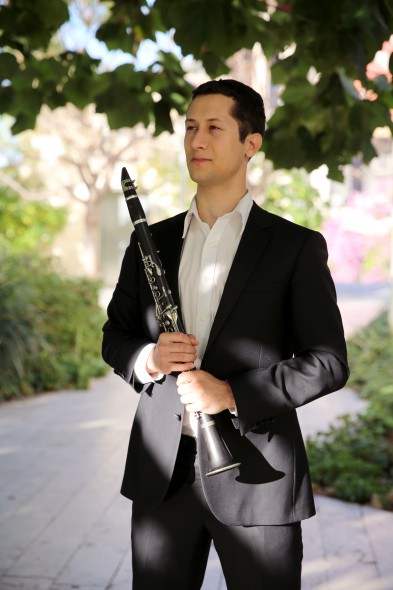Music For the End of Time
Prometheus Trio performs unique work by Messiaen, along with a Beethoven trio.
![Olivier Messiaen. Photo by Rob C. Croes / Anefo (Nationaal Archief) [CC BY-SA 3.0 (https://creativecommons.org/licenses/by-sa/3.0)], via Wikimedia Commons](https://urbanmilwaukee.com/wp-content/uploads/2017/11/Olivier_Messiaen_1986-CC-by-SA-3.0-Rob-C.-Croes-Anefo-Nationaal-Archief-443x590.jpg)
Olivier Messiaen. Photo by Rob C. Croes / Anefo (Nationaal Archief) [CC BY-SA 3.0 (https://creativecommons.org/licenses/by-sa/3.0)], via Wikimedia Commons
Twentieth-century composer Olivier Messiaen (1908-1992) broke fresh ground in his many experiments with musical form. Nothing represents his contribution better than Quatuor pour la fin du Temps (Quartet for the End of Time) (1940-41). Messiaen was constantly on the search for music that transcended the art, driven by an intense Catholic faith, a deep respect for nature and a willingness to break the rules of Western music to discover more powerful means of expression.
The back story for this work, of a premiere in a World War II prisoner of war camp, adds to the mystery surrounding it. But little about the composition was accidental nor borne of those circumstances.
Messiaen selected source material for the seven sections of the work to identify his inspiration, as in this quote from the Revelation of St. John, chapter 10 that inspired the first section:
“And I saw another mighty angel come down from heaven, wrapped in a cloud, with a rainbow upon his head; his face was like the sun, and his legs like pillars of fire…Setting his right foot on the sea and his left foot on the land… and, standing on the sea and on the land, he raised his right hand to Heaven and swore by He who lives for ever and ever… saying: ‘There will be no more Time; but in the days when the seventh angel is to blow his trumpet, the mystery of God will be fulfilled.’ ”
Messiaen sought to express his faith through creating a sense of timelessness. The result is a mesmerizing work that succeeds in capturing that intent. Unfamiliar rhythms, often inspired by Indian ragas, lengthy passages with the slowest possible pace, shifting time signatures that do not allow the listener or player to settle and inserted bird-song from the natural world all come together in the service of a devout philosophy reflecting Messiaen’s “messiaenic” faith.
Messiaen’s use of music to conjure up the mysteries of his faith, enhanced by his synesthesia (innate vision of colors in music), his transcriptions from nature (here represented by a black bird’s song) and his substantial research into non-Western music forms, create a musical style unlike any other.
The work is very challenging to play. Each instrument is featured at times. The solo section for clarinet stands high in the clarinet repertory. Some of the most unpredictable rhythms call for unison play by the quartet. This is even more challenging as all four players must bring the same precise timing to the section, as it moves from phrase to phrase with few familiar guideposts.
As I remember previous performances of Quatuor pour la fin du Temps, I can still recall the uncanny suspension of time and the pure beauty of the instruments, particularly in solo turns. You may see angels, blue-orange specters or blackbirds — your choice.
The concert will open with a much more familiar sound. Ludwig van Beethoven (1770-1827) wrote the Trio in E-Flat Major, Op. 70, No. 2 (1808) in his mature “middle period,” but the trio contains advanced insights that return in his later works. Critic Kai Christiansen finds the work “relaxed, even-keeled, beneficent and luxurious, in parts, utterly classical as if in a fond over-the-shoulder glance back to Haydn and Mozart.” Yet “compared to Haydn’s, Beethoven’s trio in E-flat is a completely new world of sonic and instrumental expression,” the critic adds.
A balanced, slow-to-unfold opening movement is followed by a pleasant set of variations contrasting a tender major theme and an aggressive minor one. The third movement offers a cantabile melody with symmetrical phrases in a dialog between piano and strings. The final movement is led from beginning to end by a driven piano part. Reflecting its “hero’s key” of E-flat, Jacob observes that “the character of the movement is nothing short of heroic.”
The Prometheus Trio performs in the intimate setting of the Conservatory mansion’s ballroom. To accommodate the fan base of the Prometheus Trio, the concert is offered twice: Monday, December 4 and Tuesday, December 5 at 7:30 p.m.
Tickets may purchased online or at 414-276-5760. Single tickets range from $17.50 (student) to $27.50 (general), with front row seats reserved for $37.50.
The Conservatory’s location at 1584 N. Prospect Ave. conjures images of difficult parking, but an arrangement with Milwaukee Eye Care allows convenient complementary parking at 1684 N. Prospect Ave., just one block north.
The Prometheus Trio plays their third concert at the Wisconsin Conservatory on February 12 & 13, 2018. In a nod to winter, the Tuesday concert on the 13th will be offered at 11:00 a.m. The Trio will play two respected trios – by Gabriel Faure and Antonin Dvorak — along with a world premiere – Daron Hagen‘s Piano Trio No. 5 (2017).
Preview
-
A Sacred Choir, 70 Voices Strong
 Dec 14th, 2025 by Martha Brown
Dec 14th, 2025 by Martha Brown
-
Prometheus Trio Goes Bohemian
 Dec 3rd, 2025 by Martha Brown
Dec 3rd, 2025 by Martha Brown
-
Present Music Offers New Choral Works
 Nov 20th, 2025 by Michael Barndt
Nov 20th, 2025 by Michael Barndt
















Great piece. Made me want to see the concert. Actually bought the Messiaen music you wrote about.
Thanks